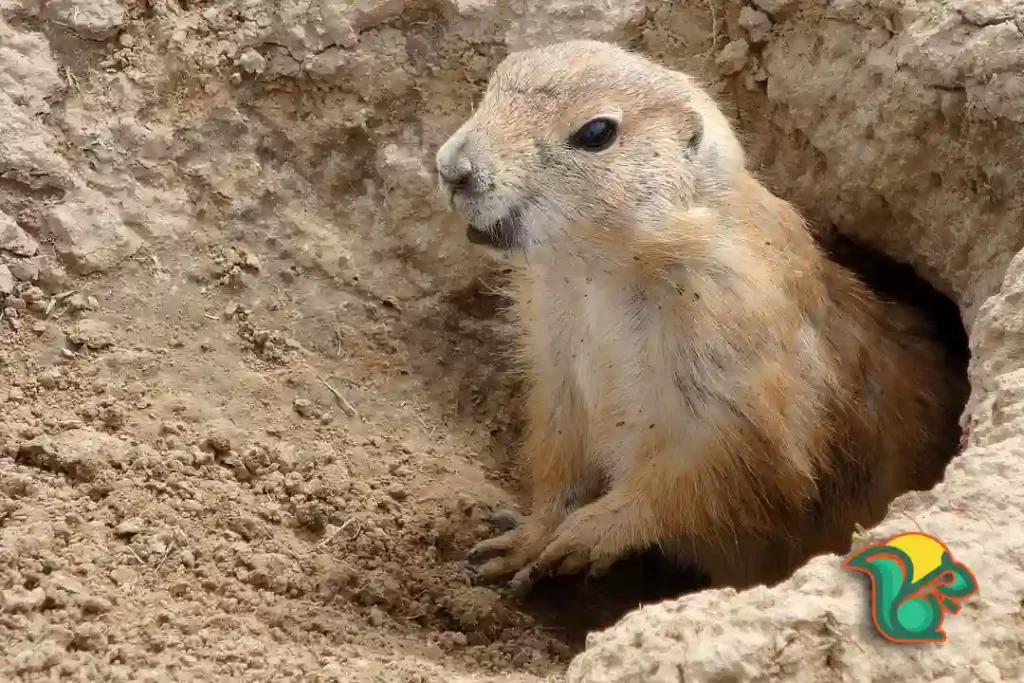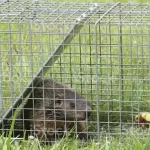How to Plug Groundhog Holes? [Complete Guide]
Groundhogs may seem like fluffy little pets, but they may damage your garden seriously. As a matter of fact, burrowers are the worst of all pests.
Additionally, groundhogs may be safely deemed the worst of the burrowing animals. If you have a groundhog in your yard and it starts digging holes, you have got a problem. So, how to plug groundhog holes?
Groundhogs can easily dig holes that are longer than you imagine. And this is not only a threat to the plants but also the soil of your property. In that case, chasing the woodchucks and taking them away will only save the plants. What are you doing for the soil?
The best way is to fill the ground and plug the holes! Let’s learn how to plug groundhog holes and fill them so that they don’t dare to come back again!

How to plug groundhog holes?
Assuming you’ve already found where the groundhog holes are in your garden, you can proceed to seal them using dirt.
But you should proceed when the hole is empty. Otherwise, if you do it while the groundhog is still inside, it will still dig its way out.
The best time to plug the groundhog holes is during summer or early fall when the tunnels are empty.
You should also do it early in the morning or in the later afternoon when the groundhog is usually most active and out there looking for food.

As for your groundhog hole filler, use topsoil or sand (or a mixture of the two). Use a shovel to drive the loose dirt surrounding the groundhog hole into the burrow. Tamp the soil to firmly pack it down.
If you can still see a depression in the rodent’s hole, it means you need to put more soil or sand.
Afterward, you can plant grass over the dirt to help regrow the spot. Or, if you’d like to hide the hole, you can cut a piece of sod that’s a bit larger than the groundhog hole and then firmly press it into the dirt.
Alternatively, you can plug the groundhog holes using large rocks or gravel. Place large rocks (the size of the groundhog burrows) on the hole opening to close it off.
Groundhogs hate digging through gravel or rocks, so they will give up trying to reopen the hole.
If you want to fill up the holes, pour gravel into the burrows and be sure to tamp it down using the back of a hoe or shovel. Keep pouring the gravel until the entire hole gets completely filled up.
Do Groundhogs Have an Aggressive Temperament?
They spend most of their lives underground, only emerging for a few hours each day to forage. In public, they shy away from contact with regular people.

The groundhog might attack without provocation if it has rabies.
Except for rabies, groundhogs pose little threat to humans and often do not spread disease to humans.
Their Habit of Burrowing
As a general fact, they do a lot of burrowing to the point that they are sometimes credited with discovering artifacts in Ohio during excavations.

They excavate elaborate subterranean tube systems with their claws, including several interconnected chambers. These may go as deep as 25 feet, have three or four entrances, and be as broad as 10 inches. Because of this, they pose a serious threat to residential buildings.
As a result of groundhogs’ longevity, humans have developed several deterrents throughout the years. Let us talk about the most efficient strategies.
Plugging Groundhog Holes – Steps Below
When groundhogs see food, they immediately go their way. In addition, it may provide a place of relative security for them. At the very least, they would be safer than in the vast majority of the world.
Whatever the case may be, if you want to discourage groundhogs from settling in your yard, you should take steps to reduce the area’s appeal to them.

Eliminating the beans, peas, and melons is one method for doing this. The groundhog will always be enticed by them since these are among its favorite meals
Do not intend on planting anything else until you have ensured your yard is safe, so get these crops in the ground as soon as possible. In addition, groundhogs like to dig their burrows in areas with plenty of covers.
You should immediately clear away any trash, pebbles, or timber that may have accumulated in any given region. You will need to have to destroy almost all of their hiding places.
Groundhogs consume and may hide in many different types of plants; therefore it is important to keep them pruned. As a general rule of thumb, you should prune all your plants. This will guarantee the eradication of your groundhog issue and may deter other unwanted guests as well.
These animals strongly prefer tree trunks and other pieces of wood because they use them to chew and sharpen their teeth.
Similarly, you should get rid of them. The next step is to plug the holes with gravel to prevent more groundhog damage. This may be done without calling in an exterminator.
So how do you get rid of groundhog tunnels and plug the holes? Here, we will show you a step-by-step process for this!
Step 1: Find the Holes
Whenever it comes to plugging groundhog holes, the first thing is you have to know where the hole is. You might not know what do groundhog holes look like while finding them. Well, they are medium-sized and the openings are about 10-12 inches in diameter.
You can proceed to this method only if you know any unoccupied dens or burrows of groundhogs. If you see the holes on the ground of your yard, you have to understand that these are made by the woodchucks. And this is when you have to settle for this method.
Once you know about a hole, you can easily fill it or block it. Another thing that you should bear in mind is that it is better to plug on a groundhog hole when you know that the groundhogs of the holes are already removed.
Also, if there are groundhogs in your property already, they will come back after a while. So, go through this method when you are sure that the groundhogs are away from your property or are removed. And you haven’t removed the groundhogs yet, go through the next method to get rid of them.
Step 2: Use Offensive Odor or Repellants
Some specific scents are offensive to groundhogs. And when they smell those around their dens or holes, they tend to stay away from that place. Here are some specific scents that are offensive to these cute animals. In this way, some objects they hate too.
This is also related to the odor of these objects. On the other hand, you can check out woodchuck bait for live traps and use traps to get them out of the area.
Offensive Scents
Take a look and use these offensive scents around their dens and holes so that they leave your property. If you don’t want to use these, go for the easy method. Get your hands on how to catch a groundhog with a milk jug without much effort!
They don’t like garlic, just like most human beings! The pungent smell of garlic can scare them away easily. Get your hands on garlic and take out a few cloves. Now, crush the garlic cloves and add them around the dens and holes you have found out.
This is enough; they won’t dwell in here again! After using this, flooding the holes will work just fine. So, can you flood a groundhog hole after using garlic or other repellants? Yes, you can!
If you plan to keep the groundhogs away from the crops and plants of your yard, getting your hands on cayenne pepper is enough. Yes, all you need is to pour some of it around the dens and holes of the groundhogs, they don’t like it at all!
The best way to scare the woodchucks with cayenne pepper is to spray it. Get 2 teaspoons of cayenne and add 1-quart of water to it. Pour it inside a spray bottle and use the nozzle for spraying this mixture on your plants and crops.
This will keep the groundhogs away from the plants and also from your property! And while keeping the property safe, you must know about woodchucks. Do woodchucks chuck wood or it’s just the name? Have a look and learn more!
Along with garlic, another most common groundhog repellent is lavender. Yes, yes, lavender is loved by the human but woodchucks are not human! Just the way you used garlic cloves, you have to get lavender plants and crush them a bit.
Or you can also add water to it after crushing and use a spray to spray it on the ground near the holes of groundhogs. Adding it around their holes will make them feel disgusted. Thus, they will leave and won’t come back!
Repellents
You can also use commercial repellants for throwing the groundhogs away from your property. On the other hand, you can rely on other objects too.
- Dog fur around the dens and holes can scare them away easily.
- They hate spicy food. So, settle for red pepper and add them around the holes to keep them away!
- Use blood meal on the plants as a fertilizer and add some around the dens, it’s a win-win thing for you.
- Just like dog fur, dog urine is something groundhogs will never tolerate.
Step 3: How to fill a Groundhog Tunnel

Check out the dens first. In every den, there will be more than two holes. There can be a maximum of five holes in one den too! If you are planning to plug on the hole, it’s easy for the groundhogs to plug another hole.
And for them, replacing the hole you are plugging isn’t a tough deal. Don’t let your energy go to waste. After you have found the groundhog hole, all you need to do is fill up the holes. So, how to fill groundhog holes easily?
In this process, first, you have to gather dirt to fill up the hole. Check all around the hole and gather the dirt surrounding the hole. Once you have gathered enough, start by filling up the hole with dirt. This will cover up the hole easily.
There is other stuff that you can use to fill the holes, have a look at what to use to fill groundhog holes for this! Search for other suspected holes around it. Once you find them, you have to fill them up with dirt just like this.
Step 4: Add Big Rocks
Now that you have filled the groundhog holes with dirt, it’s tough for them to stay there once again. But they can still come and re-inhabit there. You have to prevent it. And to prevent it, get your hands on some big rocks.
Groundhogs can inhabit digging the ground. But they can’t inhabit when there are rocks on the ground. So, adding some rocks to the holes will help you keep away the woodchucks from the holes they have created before!
How to fill groundhog holes under concrete?
If a groundhog has made a home under concrete slab in your home, then you need to fill the hole as soon as possible to prevent the slab from caving in future.
If no heavy loads usually pass over the affected area, then you can simply shove in as much gravel as you can. This is a good option if you can easily see the extent of the groundhog’s burrow.
One way to fill groundhog holes under concrete is by mixing up a wet slurry of gravel, sand, and cement, and then pouring it in. Afterward, you can make some more mix-up that’s a little wet and pack it right inside the hole.
Alternatively, you can fill the hole using fine gravel or coarse sand with the help of 2.3″ flex tubing or piping.
Simply slide the pipe into an end of the hole and use a pole with a slightly smaller diameter than the pipe to push the material out the pipe and into the hole all while slowly retracting the pipe.
You should also make use of the pole to firmly compact the filling content as you retract the pipe.
How to fill groundhog hole with sand?
Filling groundhog holes with sand is pretty easy. You just need to gather as much sand as it’s enough and then shovel it right into the groundhog tunnel.
Tamp the sand to help firmly pack it down the burrow. If you can still see a depression, put in more sand.

Once the hole is completely filled, you can now put some large rocks on top. These will help minimize the chances of the woodchucks coming to dig the sand out again and re-inhabit their old home.
Make sure the groundhog hole is empty before filling it with sand. This way, you can avoid trapping any groundhogs inside that may still dig their way out and leave you with another hole to worry about.
Frequently Asked Questions
1. How Deep Are Groundhog Holes?
Their burrows may be up to 20 feet (6.1 m) in length and up to 6 feet (1.8 m) in depth. The National Wildlife Federation reports that these burrows might have anything from two to a dozen openings. They often burrow in the grassy regions during the warmer months and the woodlands during the colder months.
2. How Big Are Groundhog Holes?
The typical length of a burrow system is between 50 and 100 feet, and it seldom goes more than 6 feet beneath the ground. Each burrow has a primary sleeping chamber, a secondary chamber for waste disposal, and maybe even more rooms if the inhabitants decide to build them.
3. How to Call a Groundhog Out of Its Hole?
To deter groundhogs, set up lawn windmills, spinning pinwheels, or a vibrating sonic instrument at the entrance of their tunnel or on top of their burrow. Wind chimes are another excellent means of disruption. Placing vibrating devices along the yard’s perimeter will keep the groundhog away.
4. How to Fill a Groundhog Tunnel?
Use tunnel fill to repair damage caused by groundhogs. You may use it to seal off tunnels dug by groundhogs, moles, squirrels, badgers, and any other animal whose burrows you want to eliminate.
Use Offensive Scents To Your Advantage
Just like every other animal out there, there are scents that are going to be offensive to the groundhog. Just placing these scents in the holes or around them will likely send your nuisance off scuffling in the opposite direction.
Use a castor oil mixture.
Create a supple mixture of ½ cup of castor oil and 2 cups of water. Place the mixture in a garden hose sprayer attachment and spray it in the holes or the areas where you want to deter groundhogs.
Applying the spray at least two or three times after a light rain will likely yield the best and most effective results possible.
If you want a more potent blend, you can mix 1 cup of castor oil with 2 cups of oil soap and 1 ¼ cup of hot sauce.
Wrap Up
Now you know how to plug groundhog holes.
Yes, groundhogs play a significant role in the natural world. Of course, you can not dispute that they are adorable at first glance, but if you see one digging in your yard or garden, your opinion will quickly change.
Fortunately, you can solve this issue on your own using the data we just presented. The techniques described above may not be as effective as hiring an expert, but they have stood the test of time.
Keeping away the groundhogs is necessary to keep the property safe. But getting rid of them isn’t enough. You have to deal with your property and keep it safe from the damage they have done when they were here. Follow the process, fill and plug the groundhog hole and keep it out of their reach!




